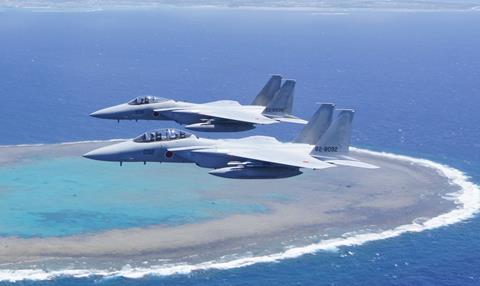Japan’s programme to upgrade its Boeing F-15Js is on track, setting the stage for the iconic type to remain a key pillar of Japanese airpower.
“This is an extremely important upgrade,” says Vince Logsdon, vice-president of international business development at Boeing Defense, Space & Security.

“But it’s not just another upgrade programme… just snapping things onto the airplane. It’s a total transformational upgrade of the jet.”
Logsdon made the remarks during a media roundtable at the Japan Aerospace show in Tokyo.
The upgrade work, to be undertaken locally by Mitsubishi Heavy Industries (MHI) with support from Boeing, will see the jets receive new electronic warfare capabilities, an active electronically scanned array (AESA) radar, an upgraded central computer, and the ability to launch long-range standoff missiles.
Logsdon says the work will put the aircraft’s capabilities on a par with the latest version of the F-15, the F-15EX now entering service with the US Air Force.
In a separate discussion with Japan’s Acquisition, Technology & Logistics Agency (ATLA), officials told FlightGlobal that the upgraded F-15 is critical for the country’s security. Although the programme had early cost and schedule issues, it was restructured three years ago and is now “on track.”
ATLA says that “around 70” F-15s will undergo the work. The Japan Air Self-Defense Force (JASDF) has around 200 F-15s in total.
When the upgrade is completed, ATLA says the F-15J “Japanese Super Interceptor” will form one pillar of JASDF combat power along with the Lockheed Martin F-35 and MHI F-2 – meanwhile, the aircraft that emerges from the Global Air Combat Programme between Italy, Japan and the UK will eventually replace the F-2.
John Suding, executive director, East Asia Defense & Government Services at Boeing, says that the company is already on contract to start delivering hardware related to the F-15 upgrade.
The project is being conducted under the Foreign Military Sales process by the US government.
The US government has offered details about key elements of the upgrade. These included the Raytheon APG-82(V)1 AESA radar, the advanced display core processor mission system computer, and the BAE Systems AN/ALQ-250 Eagle Passive Warning Survivability System (EPAWSS).
”[EPAWSS] provides the F-15 with fully-integrated radar warning, geolocation, situational awareness, and self-protection solutions to detect and defeat surface and airborne legacy, current, and future threats in highly contested, dense signal environments,” says BAE Systems.
Moreover, the aircraft will gain the ability to launch the Lockheed AGM-158 Joint Air-to-Surface Standoff Missile and other long-range strike munitions.
Updated to reflect that the upgrade includes EPAWSS.


























